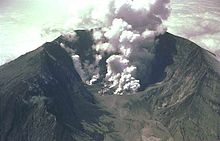
A Sturzstrom (from the German Sturz (fall) and Strom (stream, flow)) or rock avalanche is a large landslide consisting of soil and rock which travels a great horizontal distance (as much as 20 or 30 times) compared to its initial vertical drop.[1] Sturzstroms have similarities to the flow of glaciers, mudflows, and lava flows. They flow across land fairly easily, and their mobility increases when volume increases.[2][3] They have been found on other bodies in the Solar System, including the Moon, Mars, Venus, Io, Callisto, Iapetus,[4][5] and Phobos.
- ^ Hermanns, Reginald (2013-01-01), "Rock Avalanche (Sturzstrom)", Encyclopedia of Natural Hazards, Encyclopedia of Earth Sciences Series, p. 875, doi:10.1007/978-1-4020-4399-4_301, ISBN 978-90-481-8699-0, retrieved 2018-06-21
- ^ Scaringi, Gianvito; Hu, Wei; Xu, Qiang; Huang, Runqiu (2018-01-26). "Shear-Rate-Dependent Behavior of Clayey Bimaterial Interfaces at Landslide Stress Levels". Geophysical Research Letters. 45 (2): 766–777. Bibcode:2018GeoRL..45..766S. doi:10.1002/2017gl076214. ISSN 0094-8276.
- ^ Lucas, Antoine; Mangeney, Anne; Ampuero, Jean Paul (2014-03-04). "Frictional velocity-weakening in landslides on Earth and on other planetary bodies". Nature Communications. 5: 3417. Bibcode:2014NatCo...5.3417L. doi:10.1038/ncomms4417. PMID 24595169.
- ^ Singer, Kelsi N.; McKinnon, William B.; Schenk, Paul M.; Moore, Jeffrey M. (29 July 2012). "Massive ice avalanches on Iapetus mobilized by friction reduction during flash heating". Nature Geoscience. 5 (8): 574–578. Bibcode:2012NatGe...5..574S. doi:10.1038/ngeo1526.
- ^ Palmer, Jason (29 July 2012). "Saturn moon Iapetus' huge landslides stir intrigue". BBC News. Retrieved 2012-07-29.
